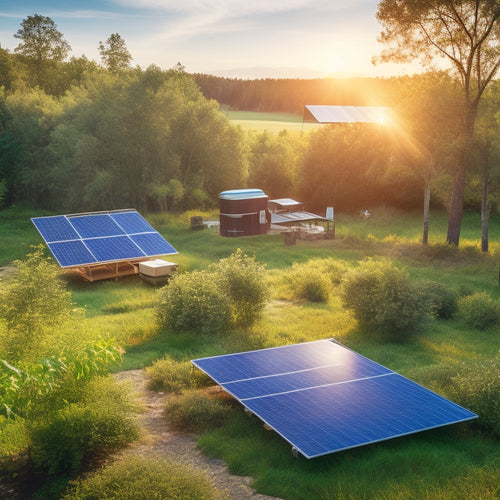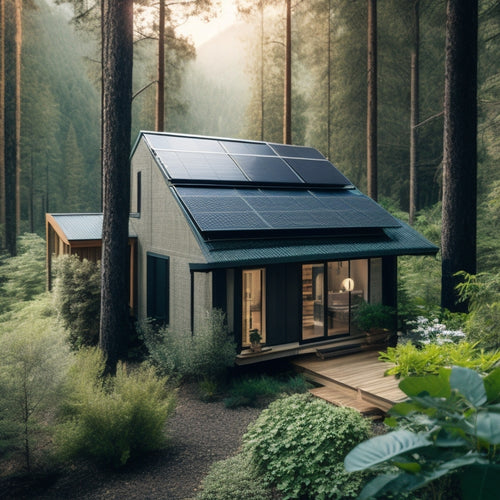
What's in a DIY Home Power Kit?
Share
You'll typically find five essential components in a DIY home power kit: a deep cycle battery for energy storage, high-efficiency solar panels for energy production, a charge controller to regulate energy flow, an inverter to convert DC power to AC, and a monitoring system to track energy production and consumption. These components work together to provide a reliable power supply for your home. As you assemble your kit, you'll need to evaluate solar panel configuration options, battery types and capacities, inverter and charge controller specifications, and proper mounting and wiring essentials. Now that you have a solid foundation, you're ready to investigate the finer details of your DIY home power kit.
Key Takeaways
- A DIY home power kit typically includes a deep cycle battery, high-efficiency solar panels, charge controller, inverter, and monitoring system.
- Solar panel configuration options include high-efficiency panels, battery bank, parallel, and series configurations for efficient energy production.
- Battery types and capacities vary, with lithium-ion, lead acid, Tesla Powerwall, and Sonnen Eco options available, each with its pros and cons.
- The inverter and charge controller are crucial components, with inverter types including pure sine wave, modified sine wave, and square wave, and charge controllers regulating energy flow.
- Proper mounting and wiring of components, including wire management systems, are essential for efficient and reliable operation of the DIY home power kit.
Key Components of a Kit
You'll need several essential components to build a functional DIY home power kit. First, you'll require a deep cycle battery with sufficient capacity to store energy for your household needs, much like the high-capacity deep cycle batteries found in Renogy and Goal Zero kits.
In addition, consider the significance of high-efficiency solar panels, which can provide ideal energy production even in cloudy weather.
Next, you'll need a charge controller to regulate the energy flow from your power source to the battery. An inverter is also vital to convert the DC power from the battery to AC power for your home appliances.
Moreover, consider a monitoring system to track your energy production and consumption, ensuring energy efficiency and facilitating cost analysis.
Solar Panel Configuration Options
With your DIY home power kit's key components in place, it's time to configure your solar panel array to maximize energy production. You'll need to decide on the best configuration for your specific needs.
When designing an off-grid system, it's vital to take into account high-efficiency panels and a strong battery bank to guarantee a reliable power supply grid independence.
For grid tie systems, you'll want to take into account a parallel configuration, where multiple panels are connected in parallel to guarantee maximum energy output. This setup is ideal for homes already connected to the grid.
For off-grid solutions, a series configuration might be more suitable, where panels are connected in series to achieve the desired voltage.
Proper configuration is important to guarantee efficient energy production and minimize energy losses.
Battery Types and Capacities
Among the various components of your DIY home power kit, batteries play an essential role in storing excess energy generated by your solar panel array, providing a reliable power supply when the sun isn't shining.
You'll need to choose the right type and capacity of batteries to meet your energy needs. Lithium-ion batteries offer several advantages, including higher energy density, longer lifespan, and lower self-discharge rates compared to traditional lead acid batteries.
However, lithium-ion batteries are generally more expensive. Lead acid batteries, on the other hand, are more affordable but have drawbacks such as lower energy density, shorter lifespan, and higher maintenance requirements.
When evaluating battery options, consider systems like the Tesla Powerwall that offer high round-trip efficiency and long warranties.
Additionally, look for systems that prioritize sustainability and eco-friendliness, such as the Sonnen Eco.
When selecting batteries, consider your energy requirements, budget, and desired level of maintenance to guarantee a reliable and efficient power supply.
Inverter and Charge Controller
As your DIY home power kit's energy storage system relies on batteries, it's equally essential to have an efficient inverter and charge controller to convert and regulate the energy flow.
The inverter's primary function is to convert DC power from your batteries to AC power for your home's appliances. You'll need to choose from three inverter types: pure sine wave, modified sine wave, or square wave, each with its own advantages and disadvantages.
A charge controller, on the other hand, regulates the energy flow from your solar panels or wind turbines to your batteries, ensuring they're charged safely and efficiently.
Key charge controller functionalities include overcharge protection, voltage regulation, and maximum power point tracking (MPPT) to optimize energy harvesting.
Mounting and Wiring Essentials
Three essential components of your DIY home power kit require careful mounting and wiring: the inverter, charge controller, and battery bank.
When mounting these components, you'll need to take into account factors like airflow, vibration, and moisture protection. Proper mounting techniques guarantee your system operates efficiently and safely.
For wiring, prioritize wiring safety by using the correct gauge and type of wire for each connection. Make certain to follow the manufacturer's guidelines for wire sizing and connection procedures.
Additionally, use wire management systems to keep your wiring organized and protected from damage. By following these guidelines, you'll secure a reliable and efficient DIY home power kit that meets your energy needs.
Frequently Asked Questions
Can I Customize My DIY Home Power Kit to Fit My Specific Energy Needs?
You can tailor your DIY home power kit to your unique energy needs by exploring customization options, such as adjustable inverters and modular battery banks, to guarantee your system accurately matches your energy consumption patterns.
How Long Does It Take to Assemble and Install a DIY Power Kit?
As you commence on this DIY journey, you're building a puzzle, piece by piece. Expect to dedicate 2-5 hours to assembly time, depending on your kit's complexity, and follow installation tips like grounding and wiring correctly to guarantee a seamless setup.
Are DIY Home Power Kits Compatible With Existing Electrical Systems?
You'll find that DIY home power kits are designed to be compatible with existing electrical systems, meeting safety standards and ensuring seamless integration, but it's essential you verify system compatibility before installation to avoid potential hazards.
Do DIY Power Kits Come With Warranties or Customer Support?
When purchasing a DIY power kit, you'll want to investigate warranty details, typically ranging from 1-5 years, and customer support options, such as phone, email, or online chat, to guarantee you're covered in case of issues or questions.
Can I Expand or Upgrade My DIY Power Kit in the Future?
You'll appreciate that most DIY power kits are designed with future upgrades in mind, offering kit scalability that allows you to add more components or replace existing ones as your energy needs evolve.
Related Posts
-

Renewable Energy Solutions to Reduce Your Carbon Footprint
To reduce your carbon footprint, adopting renewable energy solutions is key. Using solar panels or wind turbines can ...
-

Top Off Grid Solar Batteries for Renewable Energy
When seeking top off-grid solar batteries for renewable energy, consider options with advanced battery chemistry, suc...
-

Off Grid Solar Batteries
As you shift to off-grid living, you'll rely on high-performance solar batteries to store excess energy generated by ...


